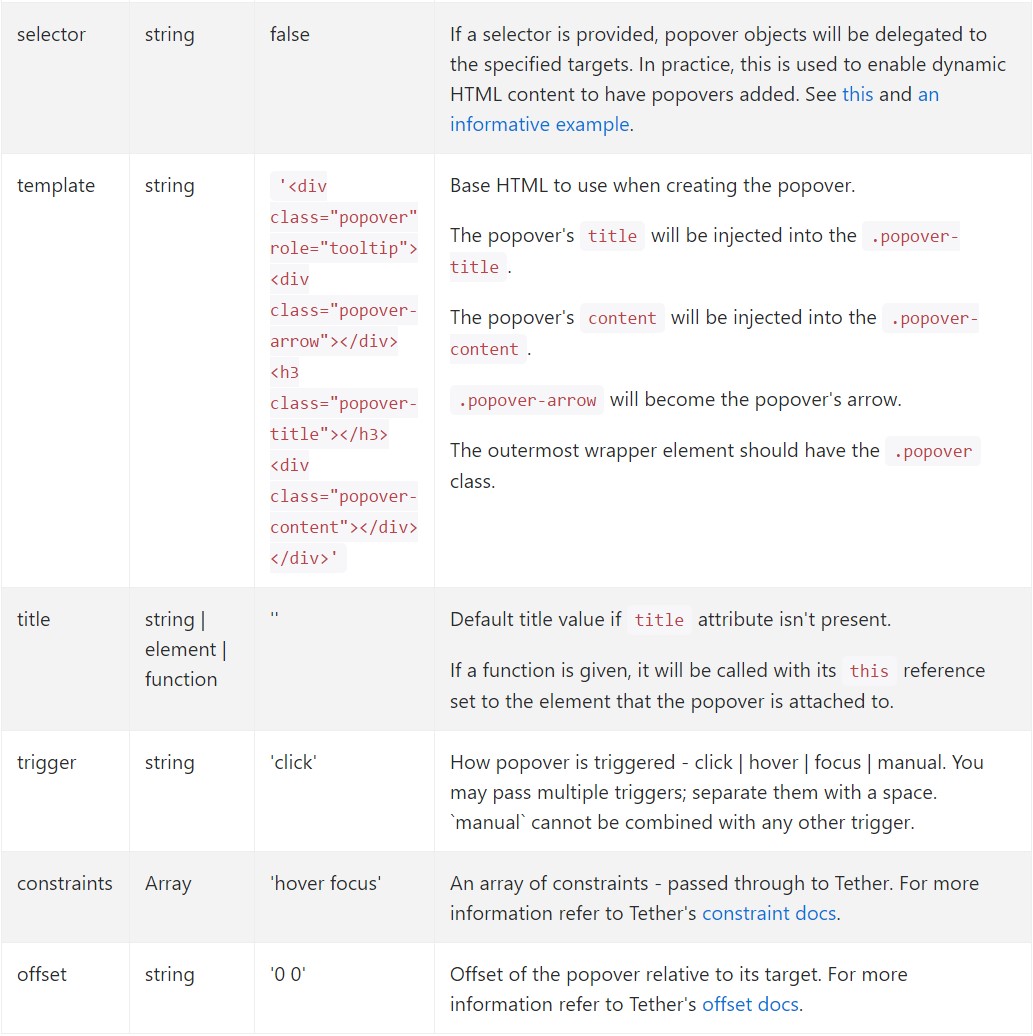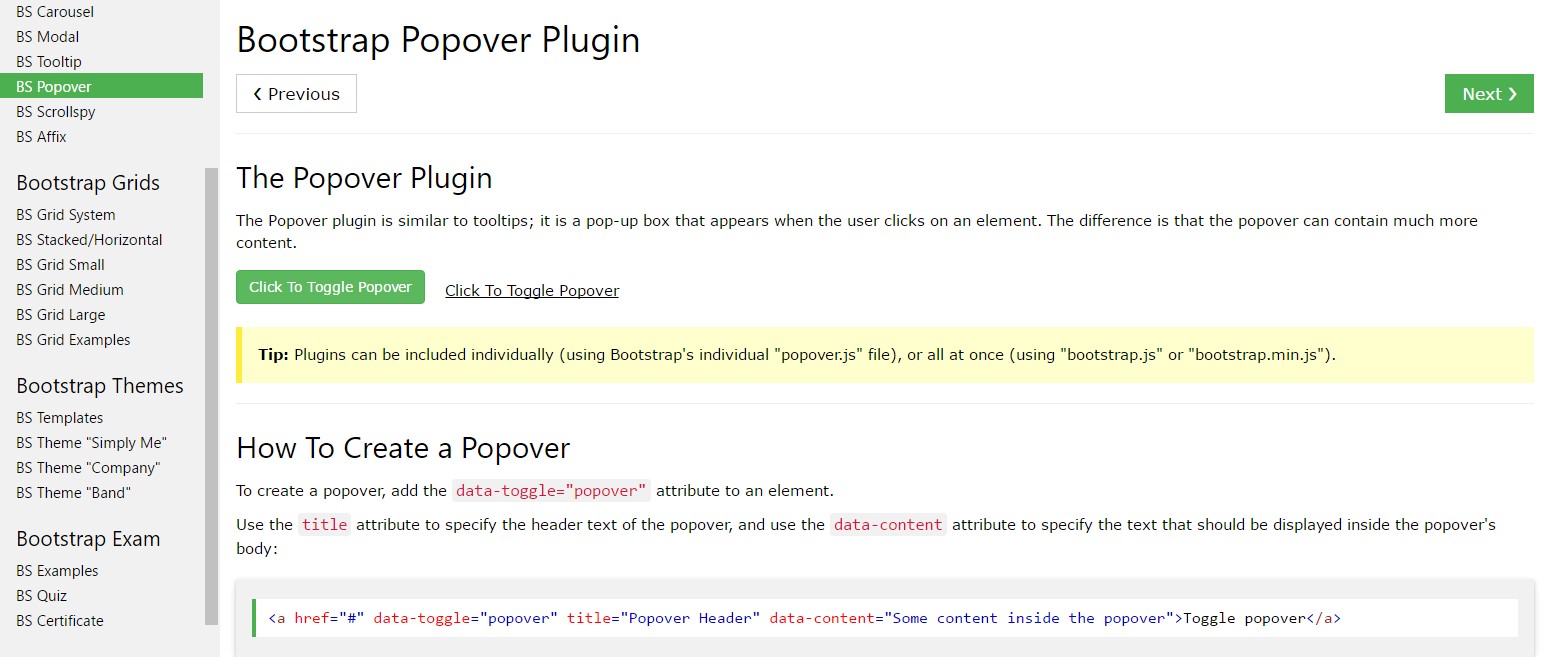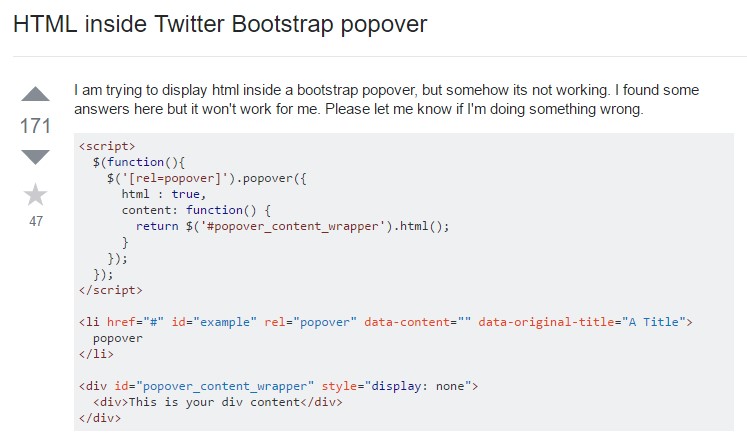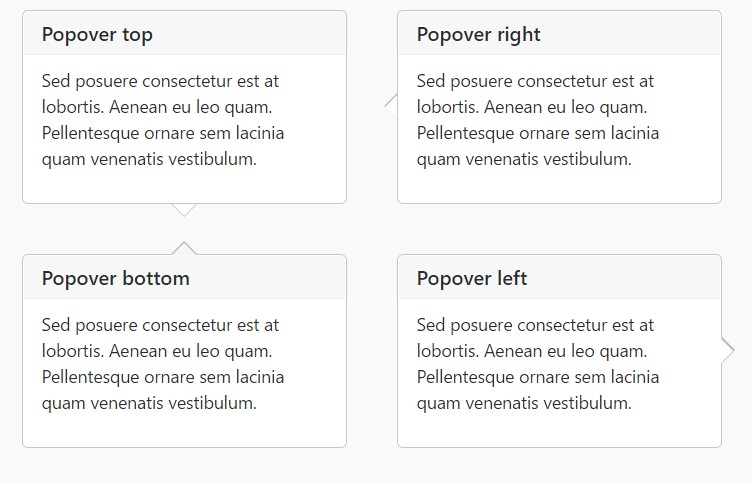Bootstrap Popover Example
Introduction
The versions
Bootstrap belongs to the greatest cost-free and handy open-source sites to start web sites. Newest version of the Bootstrap system is named the Bootstrap 4. The program is already in the alpha-testing phase still, is accessible to internet developers throughout the world. You can actually make and show changes to the Bootstrap 4 just before its final version is delivered.
Usefulness of the Bootstrap 4
With Bootstrap 4 you can surely get your site now much faster than ever. It is comparatively really easier to utilize Bootstrap to design your site than other programs. With the integration of HTML, CSS, and JS framework it is among the absolute most well-known platforms for web site advancement.
Amazing elements and methods in Bootstrap 4
Some of the most recommended capabilities of the Bootstrap 4 feature:
• An improved grid structure that enables the user to get mobile device responsive web sites along with a fair level of easiness.
• A number of utility instruction sets have been provided in the Bootstrap 4 to provide simple studying for beginners in the business of online design.
Things to take note
Step 2: Rewrite your article by highlighting words and phrases.
Together with the introduction of the new Bootstrap 4, the ties to the earlier version, Bootstrap 3 have not been absolutely removed. The creators have guaranteed that the Bootstrap 3 does get proper improve and error resolve alongside renovations. It will be performed even after the ultimate produce of the Bootstrap 4. Bootstrap 3 have not been absolutely cut off. The developers has provided that the Bootstrap 3 does get regular improve and bug fixes along with improvements.
Differences comparing Bootstrap 4 and Bootstrap 3
• The support for different browsers together with running systems has been involved in the Bootstrap 4
• The total size of the font style is boosted for relaxing reading and website advancement practical experience
• The renaming of a variety of components has been accomplished to ensure a faster and more reliable website development activity
• Using brand-new modifications, it is possible to establish a more active web site with minimal efforts
Bootstrap Popover Example
And right away let all of us access the essential theme.
When you like to bring in special secondary information on your web site you are able to apply popovers - just incorporate small-sized overlay content.
Effective ways to work with the popover plugin:
- Bootstrap Popover Options lean on the Third side library Tether for setting. You will need to provide tether.min.js prior to bootstrap.js in order for popovers to run!
- Popovers need the tooltip plugin being a dependence .
- Popovers are opt-in for functionality causes, and so you will need to activate them by yourself.
- Zero-length
titlecontent- Specify
container:'body'- Generating popovers on hidden components will definitely never do the job.
- If triggered directly from links that span various lines, popovers will certainly be centered. Use
white-space: nowrap;<a>Did you gotten the idea? Wonderful, why don't we view ways they perform with some illustrations. (see page)
You have to feature tether.min.js just before bootstrap.js in order for popovers to work!
Illustration: Set up popovers anywhere
One approach to activate all of the popovers on a webpage would undoubtedly be to select them by their
data-toggle$(function ()
$('[data-toggle="popover"]').popover()
)Example: Using the container option
Every time you have several designs on a parent component that interfere with a popover, you'll prefer to indicate a custom-made
container$(function ()
$('.example-popover').popover(
container: 'body'
)
)Static popover
Four selections are offered: top, right, bottom, and left aligned.
Live demo

<button type="button" class="btn btn-lg btn-danger" data-toggle="popover" title="Popover title" data-content="And here's some amazing content. It's very engaging. Right?">Click to toggle popover</button>Four ways

<button type="button" class="btn btn-secondary" data-container="body" data-toggle="popover" data-placement="top" data-content="Vivamus sagittis lacus vel augue laoreet rutrum faucibus.">
Popover on top
</button>
<button type="button" class="btn btn-secondary" data-container="body" data-toggle="popover" data-placement="right" data-content="Vivamus sagittis lacus vel augue laoreet rutrum faucibus.">
Popover on right
</button>
<button type="button" class="btn btn-secondary" data-container="body" data-toggle="popover" data-placement="bottom" data-content="Vivamus
sagittis lacus vel augue laoreet rutrum faucibus.">
Popover on bottom
</button>
<button type="button" class="btn btn-secondary" data-container="body" data-toggle="popover" data-placement="left" data-content="Vivamus sagittis lacus vel augue laoreet rutrum faucibus.">
Popover on left
</button>Dismiss on next click
Use the
focusSpecific markup required for dismiss-on-next-click
For right cross-browser as well as cross-platform actions, you will need to work with the
<a><button>tabindex
<a tabindex="0" class="btn btn-lg btn-danger" role="button" data-toggle="popover" data-trigger="focus" title="Dismissible popover" data-content="And here's some amazing content. It's very engaging. Right?">Dismissible popover</a>$('.popover-dismiss').popover(
trigger: 'focus'
)Treatment
Empower popovers through JavaScript
$('#example').popover(options)Methods
Selections can possibly be passed by using data attributes or JavaScript. For data attributes, attach the option name to
data-data-animation=""

Data attributes for separate popovers
Options for individual popovers have the ability to additionally be specified via the application of data attributes, being explained above.
Techniques
$().popover(options)
Initializes popovers with regard to the feature selection.
.popover('show')
Exposes an element's popover. Come back to the caller right before the popover has certainly been shown (i.e. prior to the shown.bs.popover
event happens). This is considered a "manual" triggering of the popover. Popovers whose both title and material are zero-length are never displayed.
$('#element').popover('show')
.popover('hide')
Conceals an element's popover. Go back to the user just before the popover has truly been concealed (i.e. before the hidden.bs.popover
activity occurs). This is regarded a "manual" triggering of the popover.
$('#element').popover('hide')
.popover('toggle')
Activate an element's popover. Returns to the user just before the popover has really been demonstrated or taken cover (i.e. before the shown.bs.popover
or hidden.bs.popover
event happens). This is thought of a "manual" triggering of the popover.
$('#element').popover('toggle')
.popover('dispose')
Disguise and destroys an element's popover. Popovers which work with delegation ( that are developed working with the selector option) can not really be individually eliminated on descendant trigger components.
$('#element').popover('dispose')
Events

$('#myPopover').on('hidden.bs.popover', function ()
// do something…
)
Inspect a few video guides about Bootstrap popovers
Linked topics:
Bootstrap popovers official documentation

Bootstrap popovers information

Bootstrap Popover trouble

$().popover(options)
Initializes popovers with regard to the feature selection.
$().popover(options).popover('show')
Exposes an element's popover. Come back to the caller right before the popover has certainly been shown (i.e. prior to the .popover('show')shown.bs.popover$('#element').popover('show').popover('hide')
Conceals an element's popover. Go back to the user just before the popover has truly been concealed (i.e. before the .popover('hide')hidden.bs.popover$('#element').popover('hide').popover('toggle')
Activate an element's popover. Returns to the user just before the popover has really been demonstrated or taken cover (i.e. before the .popover('toggle')shown.bs.popoverhidden.bs.popover$('#element').popover('toggle').popover('dispose')
Disguise and destroys an element's popover. Popovers which work with delegation ( that are developed working with the selector option) can not really be individually eliminated on descendant trigger components.
.popover('dispose')$('#element').popover('dispose')Events

$('#myPopover').on('hidden.bs.popover', function ()
// do something…
)Inspect a few video guides about Bootstrap popovers
Linked topics:
Bootstrap popovers official documentation

Bootstrap popovers information

Bootstrap Popover trouble

